Geographic Information System-Based Database for Monitoring and Assessing Mining Impacts on Water Resources and Environmental Systems at National Scale: A Case Study of Morocco (North Africa)
Abstract
1. Introduction
2. Materials and Methods
2.1. Study Area
2.2. Methodological Approach
2.3. Geospatial Database Design
2.4. Data Collection and Processing
2.4.1. Mine Sites
2.4.2. Mining Waste
2.4.3. Geology
2.4.4. Administrative Subdivision and Urban Agglomeration
2.4.5. Transport Facilities
2.4.6. Forest and Ecological Sites
2.4.7. Water Resources
2.5. The Implementation of the GIS-Based Environmental Database
3. Results
3.1. Distribution of Mines According to Their Status
3.2. Distribution of Mines in Morocco Regions
3.3. Distribution of Moroccan Mines by Ore Category
3.4. Mines and Water Resources
3.4.1. Distribution of Mines According to Watersheds
3.4.2. Distribution of Mines According to Their Proximity to Dams and Hydrographic Networks
3.5. Distribution of Mines According to Their Proximity to Oases
3.6. Mines and Acid Mine Drainage (AMD) Potential
3.7. Prioritized Mining Sites
4. Conclusions
Author Contributions
Funding
Data Availability Statement
Conflicts of Interest
References
- Ji, K.; Kim, J.; Lee, M.; Park, S.; Kwon, H.J.; Cheong, H.K.; Jang, J.Y.; Kim, D.S.; Yu, S.; Kim, Y.W. Assessment of exposure toheavy metals and health risks among residents near abandoned metal mines in Goseong, Korea. Environ. Pollut. 2008, 178, 322–328. [Google Scholar] [CrossRef] [PubMed]
- Paternie, E.D.E.; Hakkou, R.; Nga, L.E.; Oyono, L.D.B.; Bessa, A.Z.E.; Oubaha, S.; Khalil, A. Geochemistry and geostatistics for the assessment of trace elements contamination in soil and stream sediments in abandoned artisanal small-scale gold mining (Bétaré-Oya, Cameroon). Appl. Geochem. 2023, 150, 105592. [Google Scholar] [CrossRef]
- Opara, C.B.; Blannin, R.; Ebert, D.; Frenzel, M.; Pollmann, K.; Kutschke, S. Bioleaching of metal (loid) s from sulfidic mine tailings and waste rock from the Neves Corvo mine, Portugal, by an acidophilic consortium. Miner. Eng. 2022, 188, 107831. [Google Scholar] [CrossRef]
- Córdoba-Tovar, L.; Marrugo-Negrete, J.; Barón, P.A.R.; Díez, S. Ecological and human health risk from exposure to contaminated sediments in a tropical river impacted by gold mining in Colombia. Environ. Res. 2023, 236, 116759. [Google Scholar] [CrossRef]
- Giri, S.; Tiwari, A.K.; Mahato, M.K.; Singh, A.K. Spatio-temporal variations of metals in groundwater from an iron mining impacted area: Assessing sources and human health risk. Total Environ. Res. Themes 2023, 8, 100070. [Google Scholar] [CrossRef]
- MTEDD. Available online: https://mtedd.gov.ma/index.php?lang=en (accessed on 29 July 2023).
- Alexander, A.C.; Ndambuki, J.M. Impact of mine closure on groundwater resource: Experience from Westrand Basin-South Africa. Phys. Chem. Earth Parts A/B/C 2023, 131, 103432. [Google Scholar] [CrossRef]
- Hou, Y.; Zhao, Y.; Lu, J.; Wei, Q.; Zang, L.; Zhao, X. Environmental contamination and health risk assessment of potentially toxic trace metal elements in soils near gold mines–A global meta-analysis. Environ. Pollut. 2023, 330, 121803. [Google Scholar] [CrossRef]
- Khalil, A.; Taha, Y.; Benzaazoua, M.; Hakkou, R. Applied Methodological Approach for the Assessment of Soil Contamination by Trace Elements around Abandoned Coal Mines—A Case Study of the Jerada Coal Mine, Morocco. Minerals 2023, 13, 181. [Google Scholar] [CrossRef]
- El Adnani, M.; Rodriguez-Maroto, J.M.; Sbai, M.L.; Nejmeddine, A. Impact of polymetallic mine (Zn, Pb, Cu) residues on surface water, sediments and soils at the vicinity (Marrakech, Morocco). Environ. Technol. 2007, 28, 969–985. [Google Scholar] [CrossRef]
- El Azhari, A.; Rhoujjati, A.; Hachimi, M.L.E. Assessment of heavy metals and arsenic contamination in the sediments of the Moulouya River and the Hassan II Dam downstream of the abandoned mine Zeïda (High Moulouya, Morocco). J. Afr. Earth Sci. 2016, 119, 279–288. [Google Scholar] [CrossRef]
- Wolkersdorfer, C. Water Management at Abandoned Flooded Underground Mines: Fundamentals, Tracer Tests, Modelling, Water Treatment. In Springer Science & Business Media; Springer: Berlin/Heidelberg, Germany, 2008. [Google Scholar]
- Khalil, A.; Hanich, L.; Bannari, A.; Zouhri, L.; Pourret, O.; Hakkou, R. Assessment of soil contamination around an abandoned mine in a semi-arid environment using geochemistry and geostatistics: Pre-work of geochemical process modeling with numerical models. J. Geochem. Explor. 2013, 125, 117–129. [Google Scholar] [CrossRef]
- Khalil, A.; Argane, R.; Benzaazoua, M.; Bouzahzah, H.; Taha, Y.; Hakkou, R. Pb–Zn mine tailings reprocessing using centrifugal dense media separation. Miner. Eng. 2019, 131, 28–37. [Google Scholar]
- Ech-Charef, A.; Dekayir, A.; Jordán, G.; Rouai, M.; Chabli, A.; Qarbous, A.; El Houfy, F.Z. Soil heavy metal contamination in the vicinity of the abandoned Zeïda mine in the Upper Moulouya Basin, Morocco. Implications for airborne dust pollution under semi-arid climatic conditions. MiJournal Afr. Earth Sci. 2023, 198, 104812. [Google Scholar]
- Goumih, A.; El Adnani, M.; Hakkou, R.; Benzaazoua, M.; Ouhamdouch, S.; Boumehdi, M.A. Evaluation of the long-term contaminated neutral drainage CND generation potential of waste rock piles at the abandoned Zn-Pb erdouz mine (occidental high atlas, Morocco). Min. Metall. Explor. 2022, 39, 643–654. [Google Scholar] [CrossRef]
- El Adnani, M.; Plante, B.; Benzaazoua, M.; Hakkou, R.; Bouzahzah, H. Tailings weathering and arsenic mobility at the abandoned Zgounder silver mine, Morocco. Mine Water Env. 2016, 35, 508–524. [Google Scholar]
- Khalil, A.; Hanich, L.; Hakkou, R.; Lepage, M. GIS-based environmental database for assessing the mine pollution: A case study of an abandoned mine site in Morocco. J. Geochem. Explor. 2014, 144, 468–477. [Google Scholar]
- Kulawiak, M.; Prospathopoulos, A.; Perivoliotis, L.; Kioroglou, S.; Stepnowski, A. Interactive visualization of marine pollution monitoring and forecasting data via a Web-based GIS. Comput. Geosci. 2010, 36, 1069–1080. [Google Scholar]
- Abuhasel, K. Geographical information system based spatial and statistical analysis of the green areas in the cities of Abha and Bisha for environmental sustainability. ISPRS Int. J. Geo-Inf. 2023, 12, 333. [Google Scholar] [CrossRef]
- Kourgialas, N.N.; Hliaoutakis, A.; Argyriou, A.V.; Morianou, G.; Voulgarakis, A.E.; Kokinou, E.; Soupios, P. A web-based GIS platform supporting innovative irrigation management techniques at farm-scale for the Mediterranean island of Cret. Sci. Total Environ. 2022, 842, 156918. [Google Scholar]
- García-Ayllón, S.; Martínez, G. Analysis of correlation between anthropization phenomena and landscape values of the territory: A GIS framework based on spatial statistics. ISPRS Int. J. Geo-Inf. 2023, 12, 323. [Google Scholar]
- Mas, J.F.; Puig, H.; Palacio, J.L.; Sosa-López, A. Modelling deforestation using GIS and artificial neural networks. Environ. Model. Softw. 2004, 19, 461–471. [Google Scholar] [CrossRef]
- Ferla, G.; Caputo, P.; Colaninno, N.; Morello, E. Urban greenery management and energy planning: A GIS-based potential evaluation of pruning by-products for energy application for the city of Milan. Renew. Energy 2020, 160, 185–195. [Google Scholar] [CrossRef]
- Merbitz, H.; Buttstädt, M.; Michael, S.; Dott, W.; Schneider, C. Urban greenery management and energy planning: GIS-based identification of spatial variables enhancing heat and poor air quality in urban areas. Appl. Geogr. 2012, 33, 94–106. [Google Scholar] [CrossRef]
- Dentoni, V.; Lai, A.; Pinna, F.; Cigagna, M.; Massacci, G.; Grosso, B. A comprehensive methodology for the visual impact assessment of mines and quarries. Environ. Impact Assess. Rev. 2023, 102, 107199. [Google Scholar] [CrossRef]
- Fornasaro, S.; Morelli, G.; Rimondi, V.; Fagotti, C.; Friani, R.; Lattanzi, P.; Costagliola, P. A GIS-based map of the Hg-impacted area in the Paglia River basin (Monte Amiata Mining District–Italy): An operational instrument for environmental management. J. Geochem. Explor. 2022, 242, 107074. [Google Scholar] [CrossRef]
- Saha, A.; Gupta, B.S.; Patidar, S.; Martínez-Villegas, N. Optimal GIS interpolation techniques and multivariate statistical approach to study the soil-trace metal (loid) s distribution patterns in the agricultural surface soil of Matehuala, Mexico. J. Hazard. Mater. Adv. 2023, 9, 100243. [Google Scholar] [CrossRef]
- McIntosh, A.C.; Cushing, J.B.; Nadkarni, N.M.; Zeman, L. Database design for ecologists: Composing core entities with observations. Ecol. Inform. 2007, 2, 224–236. [Google Scholar] [CrossRef]
- Liang, T.; Werner, T.T.; Heping, X.; Jingsong, Y.; Zeming, S. A global-scale spatial assessment and geodatabase of mine areas. Glob. Planet. Change 2021, 204, 103578. [Google Scholar] [CrossRef]
- Svob, S.; Arroyo-Mora, J.P.; Kalacska, M. The development of a forestry geodatabase for natural forest management plans in Costa Rica. For. Ecol. Manag. Change 2014, 327, 240–250. [Google Scholar] [CrossRef]
- Wang, X.; Xie, H. A review on applications of remote sensing and geographic information systems (GIS) in water resources and flood risk management. Water 2018, 10, 608. [Google Scholar] [CrossRef]
- Tona, A.U.; Demir, V.; Kuşak, L.; Yakar, M. Su kaynakları mühendisliğinde CBS’nin kullanımı. Türkiye Coğrafi. Bilgi. Sist. Derg. 2022, 4, 23–33. [Google Scholar]
- Ministere de l’Energie, des Mines et de l’Environnement. Available online: https://www.mem.gov.ma/ (accessed on 29 July 2023).
- Dematerialisation de la Procedure des ’Etudes d’Impacts. Available online: https://www.environnement.gov.ma/fr (accessed on 29 July 2023).
- Ministere de l’Urbanisme, de l’Amenagement du Territoire, de l’Eau et de l’Environnement. Available online: https://www.muat.gov.ma (accessed on 29 July 2023).
- Ministere de l’Equipement, de l’Eau et de l’Environnement. Available online: http://www.equipement.gov.ma (accessed on 29 July 2023).
- Formations Forestiéres. Available online: http://www.eauxetforets.gov.ma/ForetsMarocaines (accessed on 29 July 2023).
- CHM—Clearing-House Mechanism. Available online: https://ma.chm-cbd.net/ (accessed on 29 July 2023).
- An Overview of the Analysis Toolbox—ArcGIS Pro. Available online: https://pro.arcgis.com/en/pro-app/latest/tool-reference (accessed on 29 July 2023).
- Houssni, M.; El Mahroussi, M.; Sbih, H.B.; Kadiri, M.; Ater, M. Agriculture traditionnelle et agrodiversité dans les oasis du Sud du Maroc: Cas des oasis de la région Drâa-Tafilalet. In Proceedings of the Research and Innovation as Tools for Sustainable Agriculture, Food and Nutrition Security, MEDFORUM, Bari, Italy, 18–20 September 2018. [Google Scholar]
- López-Acevedo, F.J.; Escavy, J.I.; Herrero, M.J. Application of Spatial Data Mining to national mines inventories for exploration and land planning of high place-value mineral resources. The case of aggregates in Spain. Resour. Policy 2022, 79, 103096. [Google Scholar] [CrossRef]
- Johnston, K.; Ver Hoef, J.M.; Krivoruchko, K.; Lucas, N. Using ArcGIS Geostatistical Analyst; ESRI: Redlands, CA, USA, 2001; Volume 320. [Google Scholar]
- Lim, B.; Alorro, R.D.; Aylmore, M.; Grimsey, D. Complexation leaching of critical and strategic metals from nickel converter slag using organic acids. Miner. Eng. 2023, 201, 108167. [Google Scholar]
- Conseil Economique Social et Environnement. Available online: https://www.cese.ma/docs/les-minerais-strategiques-et-critiques/ (accessed on 29 July 2023).
- Iavazzo, P.; Ducci, D.; Adamo, P.; Trifuoggi, M.; Migliozzi, A.; Boni, M. Impact of past mining activity on the quality of water and soil in the High Moulouya Valley (Morocco). Water Air Soil Pollut. 2012, 223, 573–589. [Google Scholar]
- Bouchaou, L.; Tagma, T.; Boutaleb, S.; Hssaisoune, M.; El Morjani, Z.E.A. Climate change and its impacts on groundwater resources in Morocco: The case of the Souss-Massa basin. In Climate Change Effects on Groundwater Resources: A Global Synthesis of Findings and Recommendations; Taylor & Francis: Abingdon, UK, 2011; pp. 129–144. [Google Scholar]
- Ouhamdouch, S.; Bahir, M.; Ouazar, D.; Carreira, P.M.; Zouari, K. Evaluation of climate change impact on groundwater from semi-arid environment (Essaouira Basin, Morocco) using integrated approaches. Environ. Earth Sci. 2019, 78, 449. [Google Scholar] [CrossRef]
- Kusi, K.K.; Khattabi, A.; Mhammdi, N.; Lahssini, S. Prospective evaluation of the impact of land use change on ecosystem services in the Ourika watershed, Morocco. Land Use Policy 2020, 97, 104796. [Google Scholar]
- El Khalil, H.; El Hamiani, O.; Bitton, G.; Ouazzani, N.; Boularbah, A. Heavy metal contamination from mining sites in South Morocco: Monitoring metal content and toxicity of soil runoff and groundwater. Environ. Monit. Assess. 2008, 136, 147–160. [Google Scholar] [CrossRef]
- Skousen, J.G.; Ziemkiewicz, P.F.; McDonald, L.M. Acid mine drainage formation, control and treatment: Approaches and strategies. Extr. Ind. Soc. 2019, 6, 241–249. [Google Scholar]




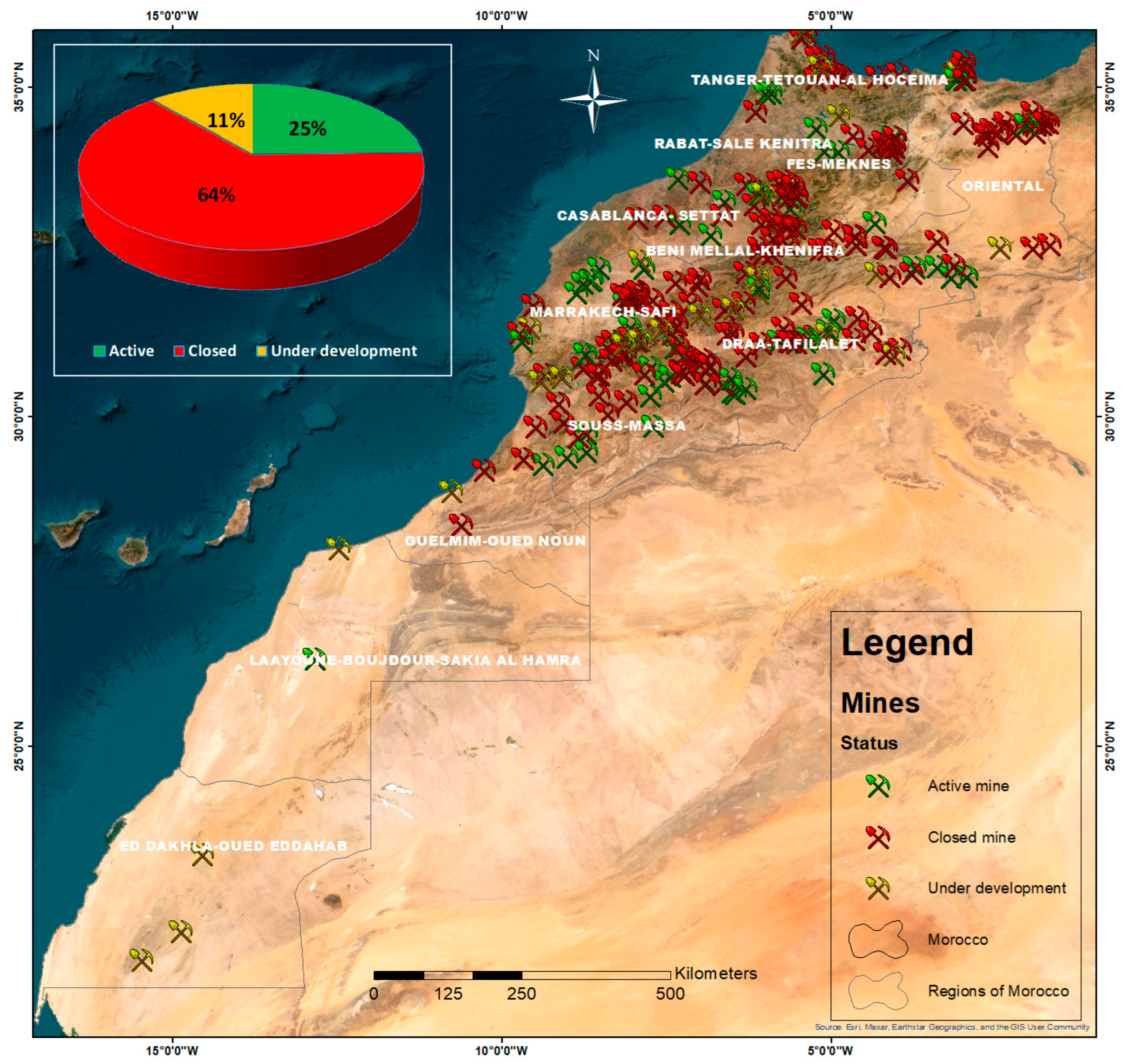
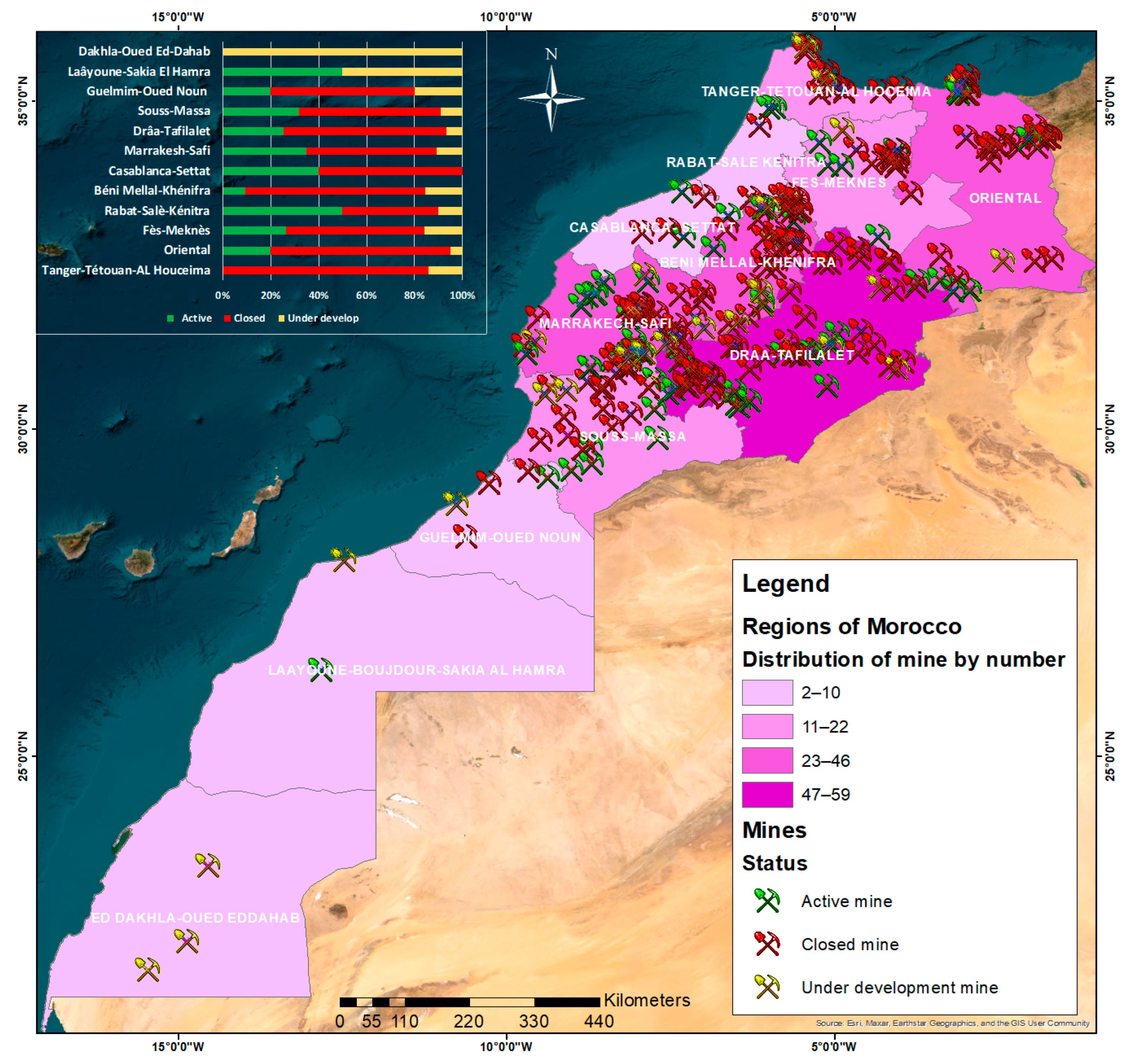
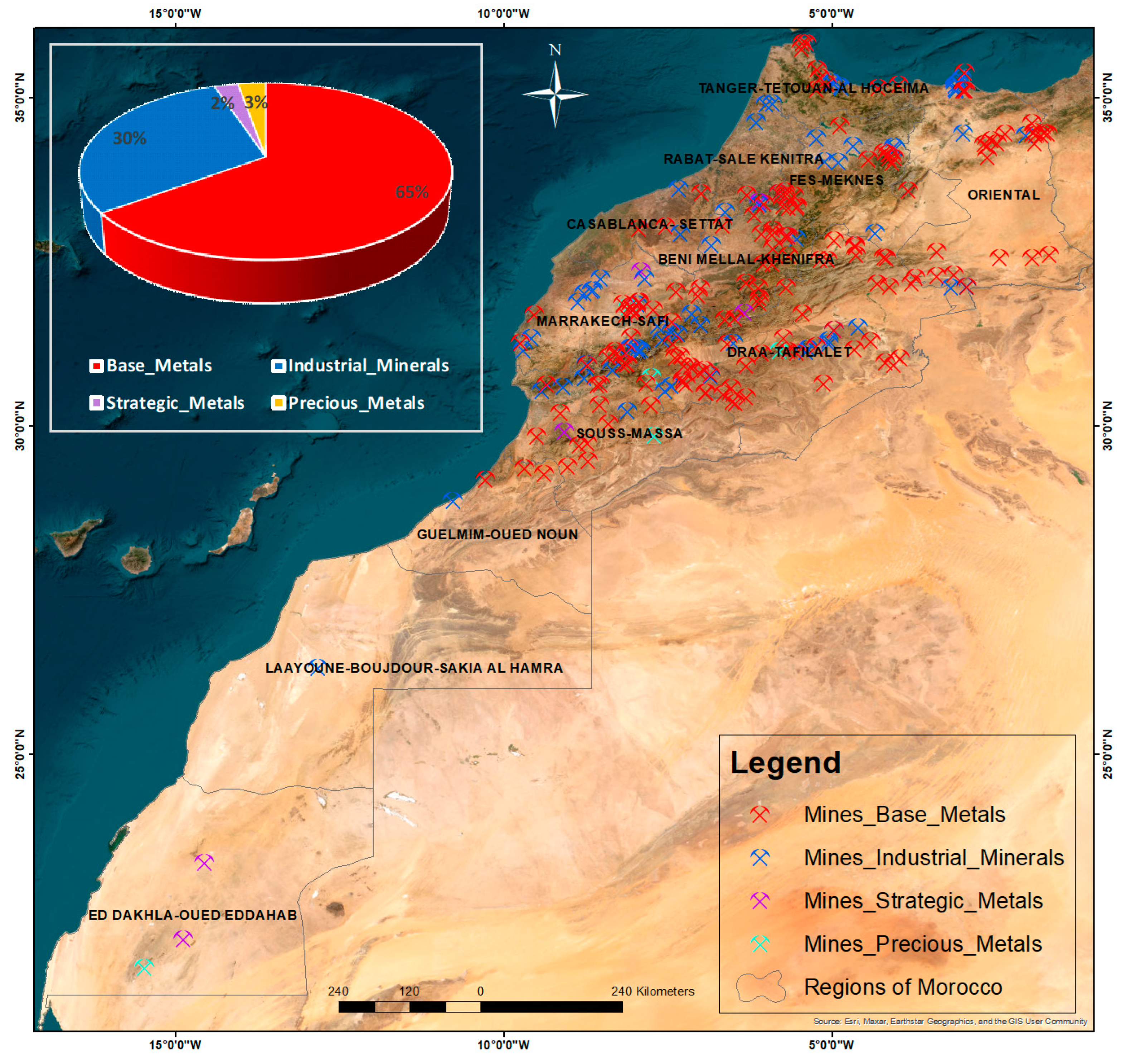

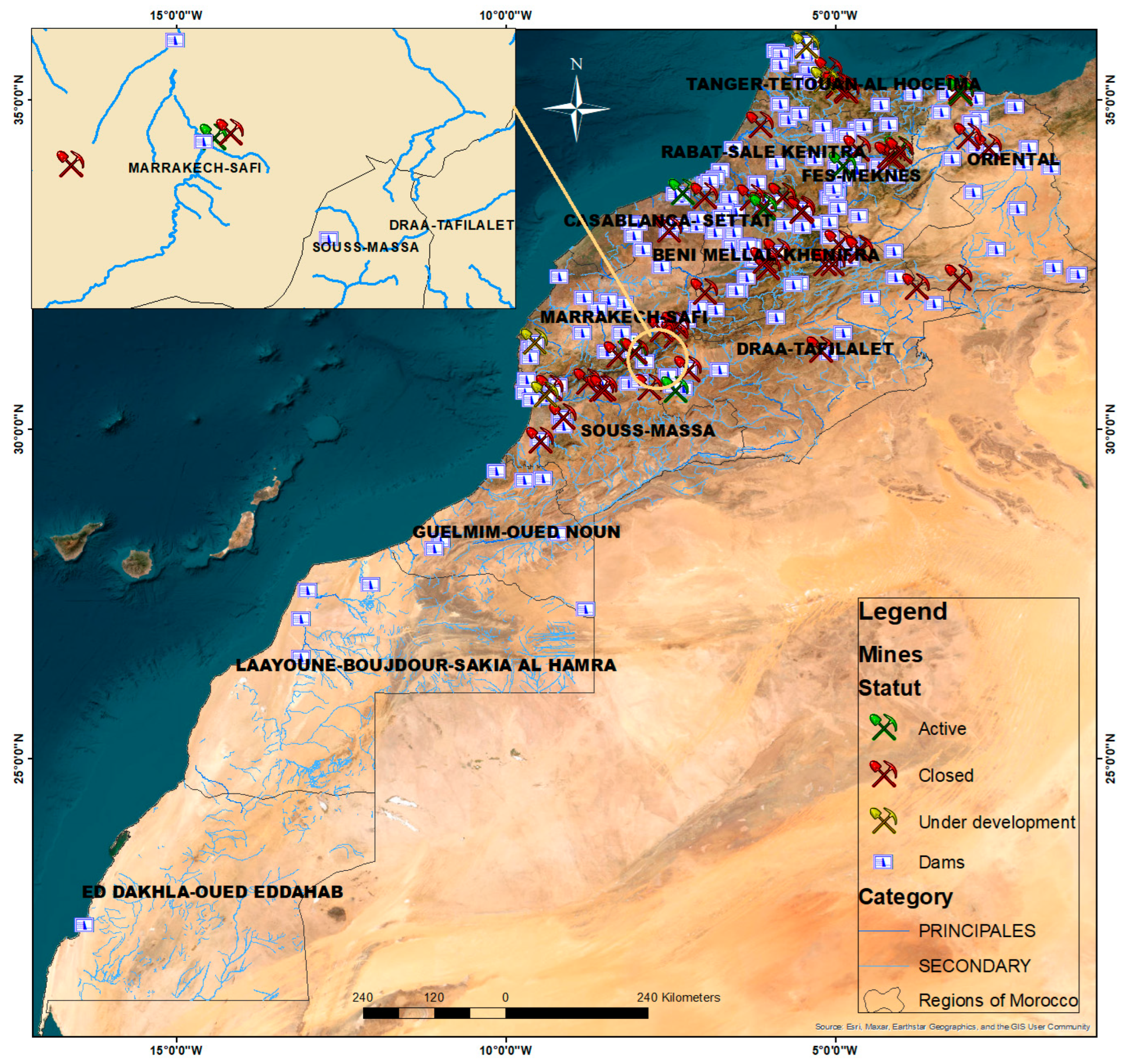
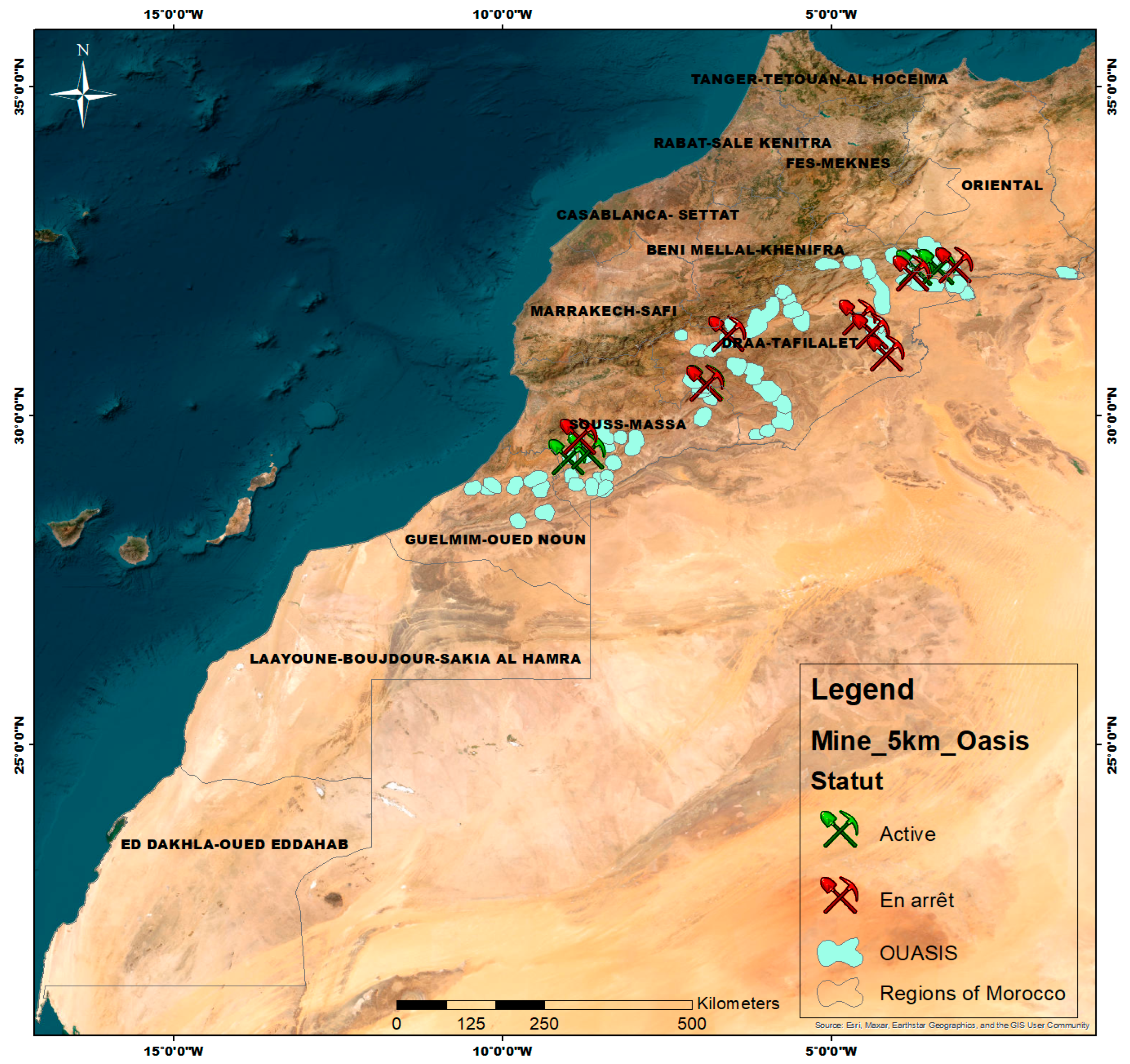
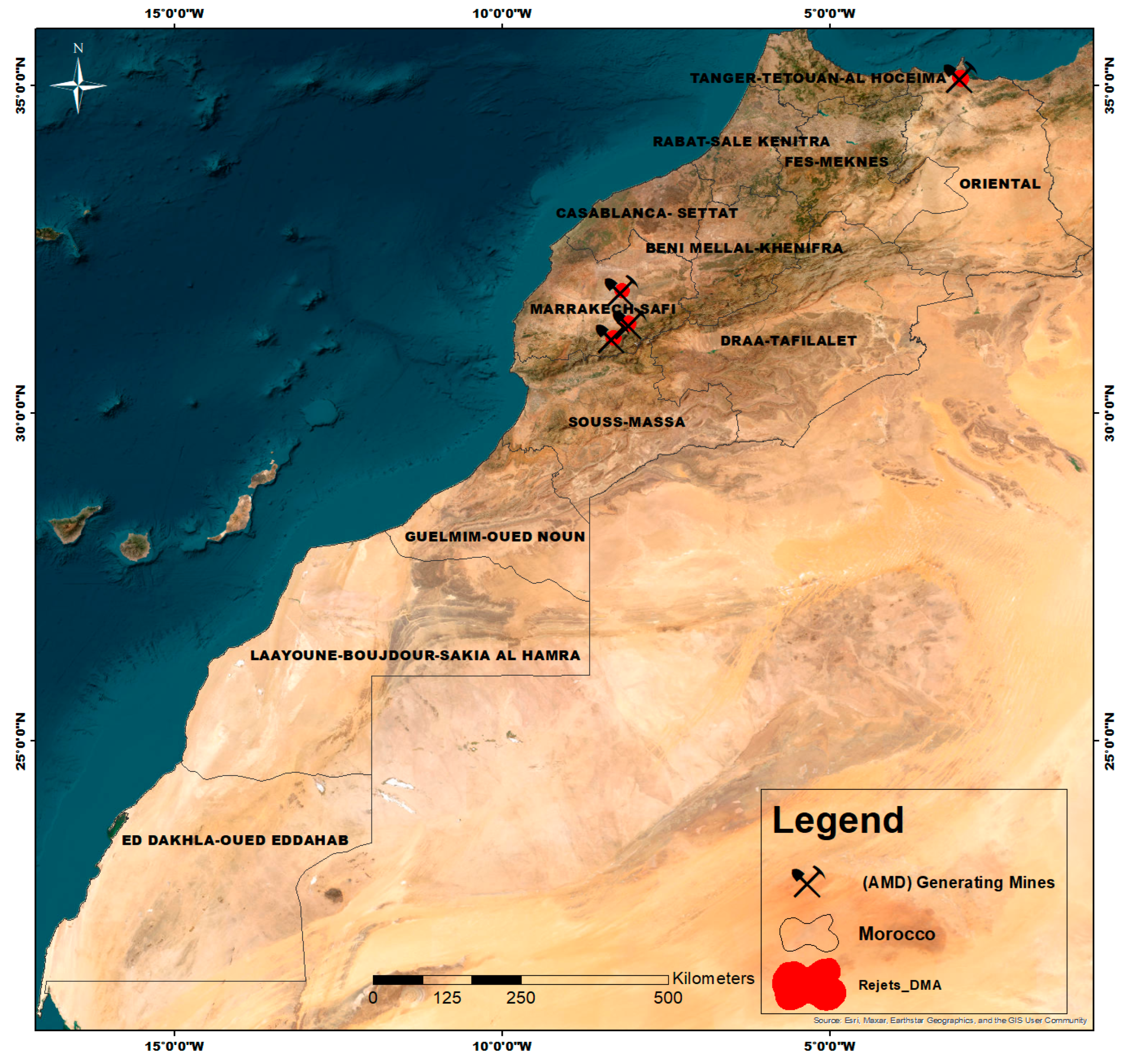

| Region | Active | Closed | Under-Develop | Total Mines | Population |
|---|---|---|---|---|---|
| Tanger-Tétouan-AlHouceima | 0 | 12 | 2 | 14 | 3,725,192 |
| Oriental | 8 | 30 | 2 | 40 | 2,402,374 |
| Fès-Meknès | 5 | 11 | 3 | 19 | 4,347,958 |
| Rabat-Salè-Kénitra | 5 | 4 | 1 | 10 | 4,769,423 |
| Béni Mellal-Khénifra | 3 | 24 | 5 | 32 | 2,581,703 |
| Casablanca-Settat | 2 | 3 | 0 | 5 | 7,218,021 |
| Marrakesh-Safi | 16 | 25 | 5 | 46 | 4,687,947 |
| Drâa-Tafilalet | 15 | 40 | 4 | 59 | 1,673,773 |
| Souss-Massa | 7 | 13 | 2 | 22 | 2,817,204 |
| Guelmim-Oued Noun | 1 | 3 | 1 | 5 | 441,800 |
| Laâyoune-Sakia El Hamra | 1 | 0 | 1 | 2 | 388,902 |
| Dakhla-Oued Ed-Dahab | 0 | 0 | 3 | 3 | 165,250 |
Disclaimer/Publisher’s Note: The statements, opinions and data contained in all publications are solely those of the individual author(s) and contributor(s) and not of MDPI and/or the editor(s). MDPI and/or the editor(s) disclaim responsibility for any injury to people or property resulting from any ideas, methods, instructions or products referred to in the content. |
© 2025 by the authors. Licensee MDPI, Basel, Switzerland. This article is an open access article distributed under the terms and conditions of the Creative Commons Attribution (CC BY) license (https://creativecommons.org/licenses/by/4.0/).
Share and Cite
Boukhari, S.; Khalil, A.; Zouhri, L.; El Adnani, M. Geographic Information System-Based Database for Monitoring and Assessing Mining Impacts on Water Resources and Environmental Systems at National Scale: A Case Study of Morocco (North Africa). Water 2025, 17, 924. https://doi.org/10.3390/w17070924
Boukhari S, Khalil A, Zouhri L, El Adnani M. Geographic Information System-Based Database for Monitoring and Assessing Mining Impacts on Water Resources and Environmental Systems at National Scale: A Case Study of Morocco (North Africa). Water. 2025; 17(7):924. https://doi.org/10.3390/w17070924
Chicago/Turabian StyleBoukhari, Salma, Abdessamad Khalil, Lahcen Zouhri, and Mariam El Adnani. 2025. "Geographic Information System-Based Database for Monitoring and Assessing Mining Impacts on Water Resources and Environmental Systems at National Scale: A Case Study of Morocco (North Africa)" Water 17, no. 7: 924. https://doi.org/10.3390/w17070924
APA StyleBoukhari, S., Khalil, A., Zouhri, L., & El Adnani, M. (2025). Geographic Information System-Based Database for Monitoring and Assessing Mining Impacts on Water Resources and Environmental Systems at National Scale: A Case Study of Morocco (North Africa). Water, 17(7), 924. https://doi.org/10.3390/w17070924









